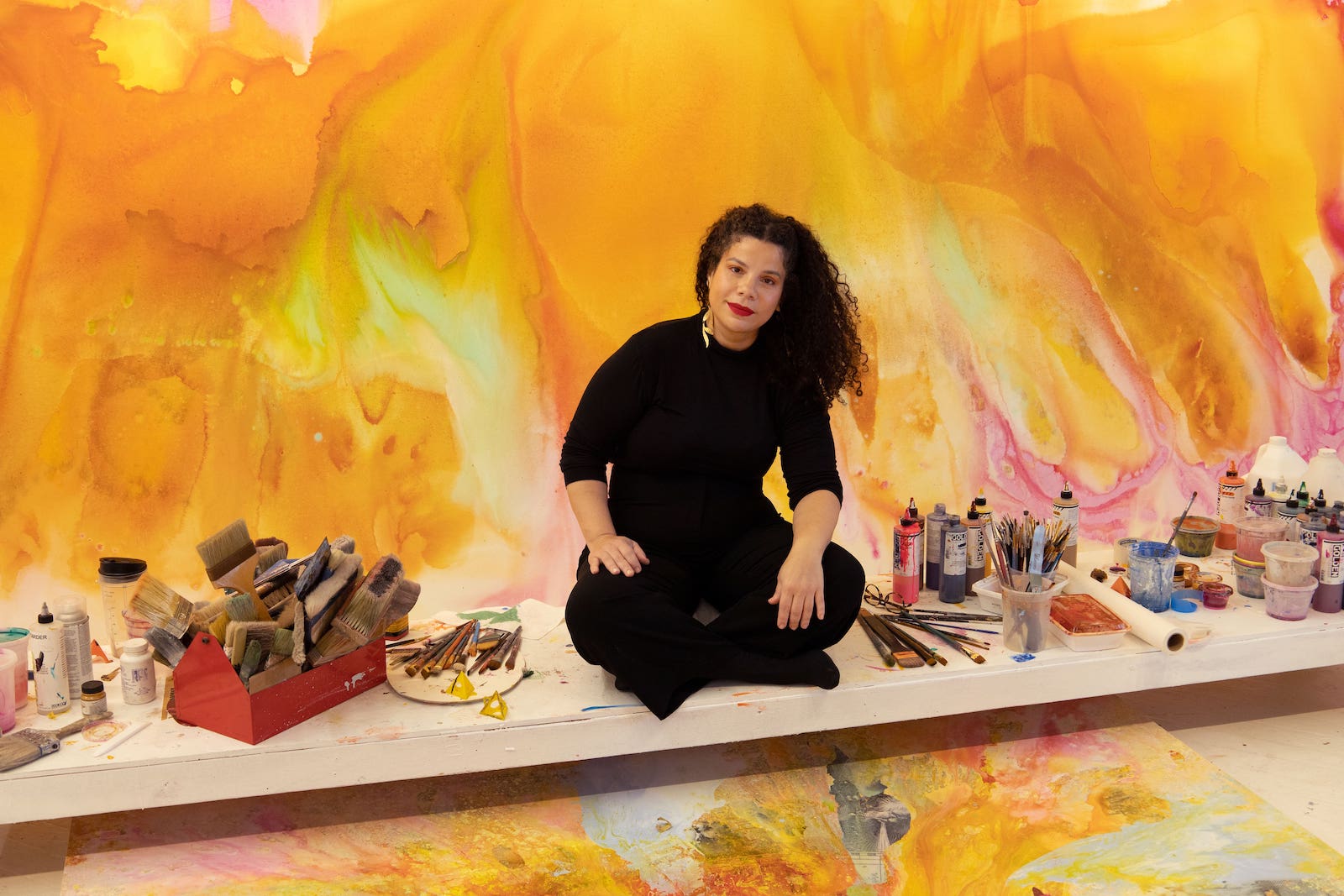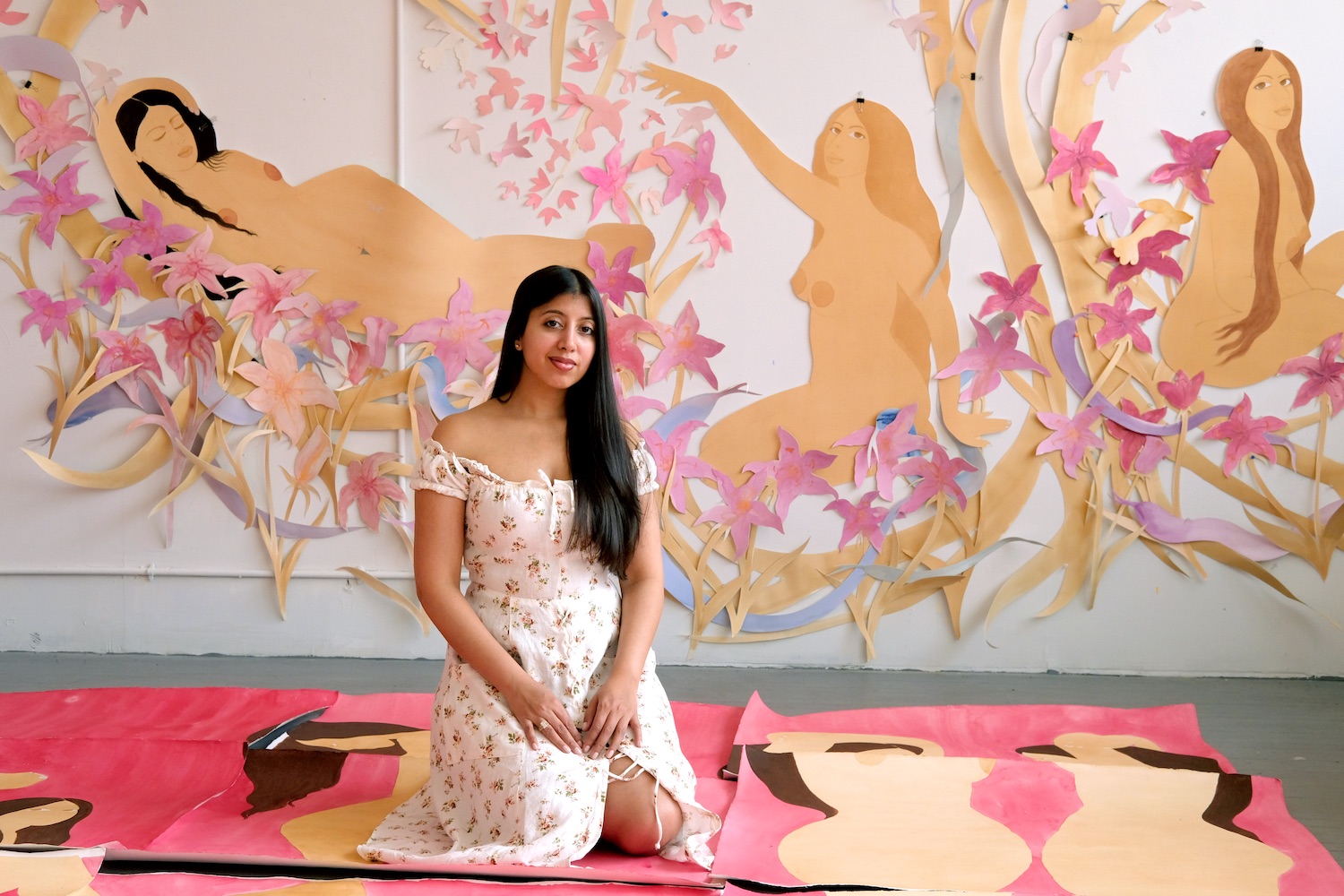A Sordid History in Explosive Beauty
The work of Firelei Báez has been compared to that of a historian. Indeed, her process pulls from intensive research, and archival documents work as the literal base for the paintings—be it astrological charts, shipping routes, ledgers, or art historical references. She approaches these complex histories with her own experience, growing up in the Caribbean and in Miami, the daughter of Haitian and Dominican parents.
In her recent exhibition, “Americananana” at James Cohan gallery in New York, she created immersive paintings that offer a dream space in which to reconsider the mythmaking around the American story. Inspired by the ancient ruins and monuments of Rome during her residency there as a Rome Prize Fellow, she started to look at framing Americana in a new light. She asked questions like, What if we acknowledged the totality of the making of America? What if we recognized its connected history with the Caribbean, Latin America, and West Africa? What if we took in the beauty with the horror? The radical with the banal? The rest with the resilience?
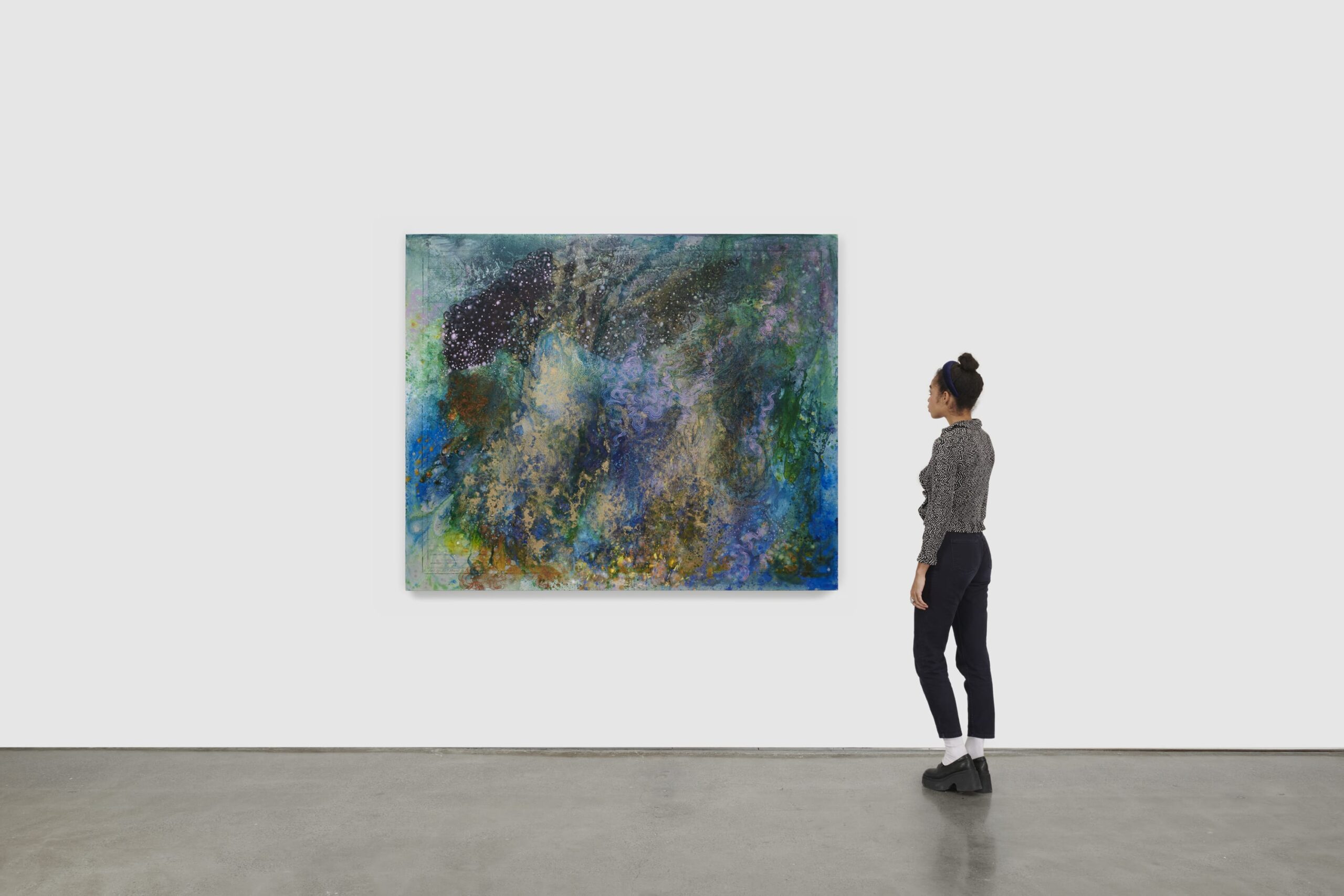
Firelei Báez, “La Sirène (Describing the West India Navigation, from Hudson’s-Bay to the River Amazones),” 2022, oil and acrylic on archival printed canvas, 73 7/8 x 60 7/8 inches, photo by Phoebe d’Heurle, courtesy of the artist and James Cohan, New York.
The resulting paintings are spectacularly full of color, movement, detail, and feeling. They draw you in with silken hair, a spectrum of vibrancy, the luscious curve of ripe fruit. And the closer you get you may feel a growing sense of unease, a realization, a great connection, a more nuanced understanding.
Whitewall spoke with Báez about how what she offers to the viewer is just the beginning.
WHITEWALL: What was the initial idea, the seed, that grew into “Americananana” at James Cohan gallery last fall?
FIRELEI BÁEZ: It’s a show that had been in the works for about a year. Ones that were longer in the making are because I had to leave the country to go to residency in Rome for about eight months out of a whole year. There is so much mythmaking there about Roman identity. Given that it has thousands and thousands of years of history to go back on, you can tell from the monuments what they choose to focus on is very much revealing of whatever part of their identity they want to have present.
Being in that space made me really question how much of that world-building or identity-building is present within our own country. I started looking at the foundational myths of the thin veneer that is Americana. Can you learn to reappreciate something in its full complexity? Can you consider the good, the comfort, and the damage it’s done? Is there a space for reconciliation in full truthfulness?
I grew up in the Caribbean and in Miami. What I wanted to do with this show was expand that foundation to understand how American is the Americas. How a way of reconciling and making a more generous framing around who we are would be to really consider the intertwinedness of the Americas.
There is one painting of what looks like a hurricane full of icebergs. In that one, the original diagram is propaganda from Pan Am for tourism along its routes through Latin America. What was fascinating to me was that those routes almost mimic exactly the transatlantic slave trade. It’s fascinating how you can maybe acknowledge one or not the other. I would really want to eliminate that separation. Is there any way of accessing a space other than a dream space to think of two opposing ideas coming together?
In the Caribbean, things that would not compute elsewhere are activated there. And it almost feels like a laboratory for everything that came after—this laboratory landing spot where laws around race, the workday hours were established out of slavery there, all these different migratory patterns that happened in the Americas first happened there. It’s a strange wish for interconnectedness that could bring awareness, and I don’t know how other than in a dream space.
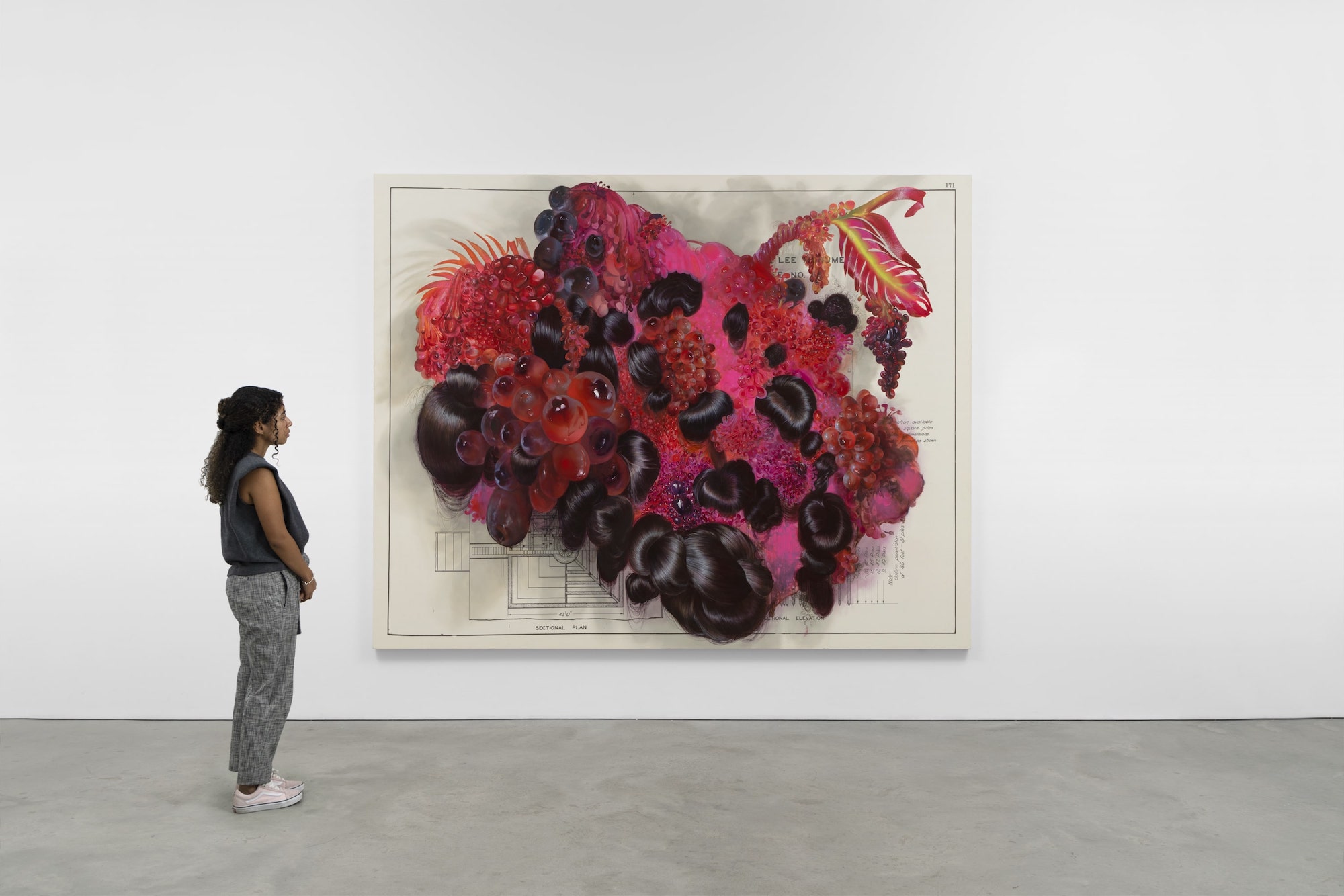
Firelei Báez, “Fruta Fina, Fruta Estrańa (Lee Monument),” 2022 Oil and acrylic on archival printed canvas, 88 1/4 x 111 inches; photo by Jackie Furtado, courtesy of the artist and James Cohan, New York.
WW: What were some of the myths you wanted to further investigate?
FB: There are these two paintings of Drexciya, which are, speaking of Americana, a modern American myth. These two DJs from Detroit, the Drexciya duo, in the nineties, over a series of nine albums in their album covers developed this idea of a Black Atlantis starting from the point of reimagining. There’s this painting by J.M.W. Turner of a ship with enslaved figures thrown overboard to claim the insurance value for them. It became a scandal in London, but at the time it was a precedent for even categorizing enslaved people as less than human. This insurance value furthered that entire process. The horrors of data, you have that as a factum in history: People were thrown overboard to claim insurance value. The value of a human being was quantifiable in money. Backing up from that space, how do you create a moment of imagination and possibility for something beyond that?
So they imagined, what if the pregnant women thrown overboard survived and their babies survived? And the babies developed the ability to breathe underwater in their womb? What kind of flourishing Atlantis would they have formed? What would have sounded like? What would their joys and their battles and their technology have been like? It’s pretty amazing. It’s such a vibrant story that it has inspired so many creatives, writers, painters, musicians. There’s a Venn diagram of the influence of the brilliance of Octavia Butler and the Drexciya duo.
What is a bigger truth than the bracket that we’re limited to? These two paintings delve from this release of person, release of perception, to these rich imagined worlds of Drexciya.
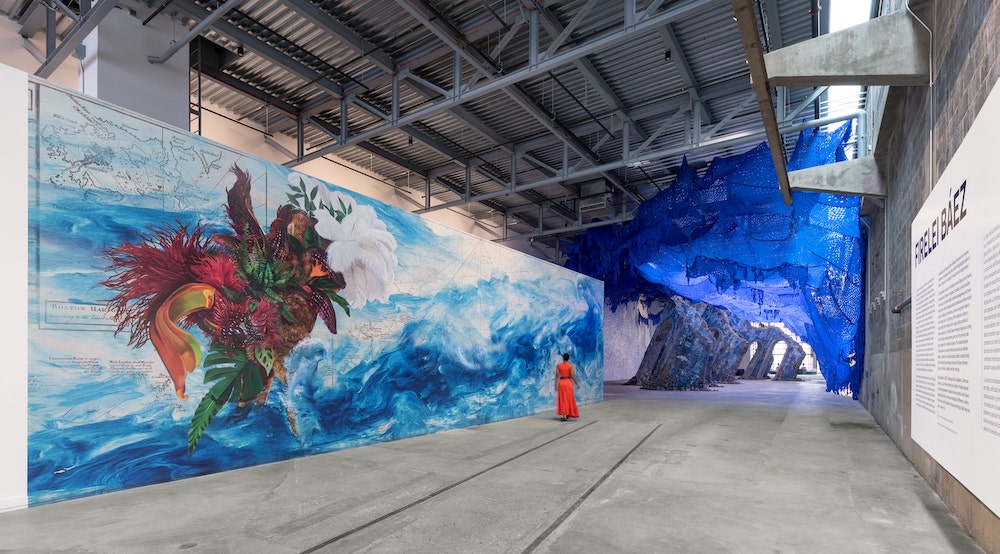
Firelei Báez, “To breathe full and free: a declaration, a re-visioning, a correction (19°36’16.9”N 72°13’07.0”W, 42° 21’48.762” N 71°1’59.628” W),” 2021, installation view; photo by Chuck Choi, © Firelei Báez 2023, courtesy of the artist and James Cohan, New York.
WW: You’ve spoken about the notion of beauty as being something subversive. And that speaks to what you were talking about in terms of in the face of something devastating, a troubling history, how can you imagine making something imaginative and fantastic and beautiful?
FB: That is one of the biggest gifts of that space, to bring myself back to earth. It is something that will be remade anew by the perceptions of the viewer. Whatever you’re bringing in, whatever your experiences are, will either expand or contract whatever is given. But the more of us that experience it, the more informed we are. So much of what we experience, until we see it fully, in multitude, we can’t really see something until we name something. It’s not just an outward gift, it’s a gift back to have people expand whatever gesture I can make. In the viewing, people are actively transforming the work. And you can only dream of that.
The book page pieces that influence the works that are in the show were about a collective destruction. They are unglazed, and I make these very delicate, minute marks on them that are meant to draw the viewer in. And the viewers’ breath is the work for me, rather than the mark-making it. Because the hope is to collectively destroy that underlying document. All the things that are transforming the object itself are your presence locked in. I’m trying to figure out how to do that with these larger works. What is that moment where you’re indelibly leaving yourself behind? You have the gaze, but you have whatever humidity is in your hair from outside or whatever you carried with you to the gallery you leave behind. And that, for me, is such a fruitful space. How do I do that with a painted image?
“I think of these larger sculptures as permeable paintings.” — Firelei Báez
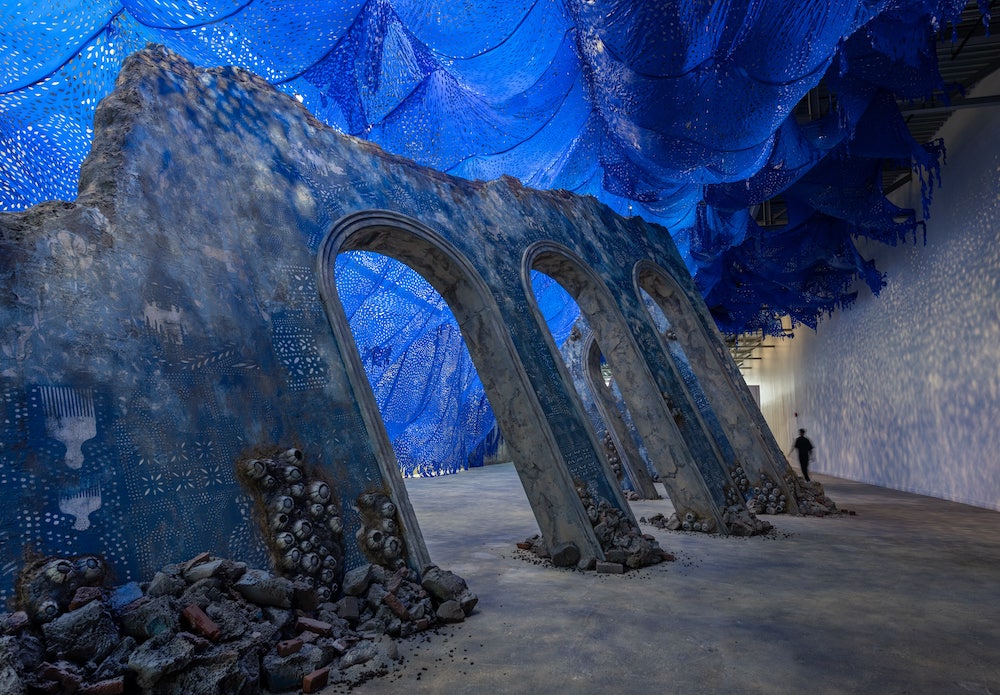
Firelei Báez, “To breathe full and free: a declaration, a re-visioning, a correction (19°36’16.9”N 72°13’07.0”W, 42° 21’48.762” N 71°1’59.628” W),” 2021, mixed media installation with sound, acrylic, polystyrene foam, plywood, aluminum, rubber, perforated tarp, 32 audio tracks, 19 feet 8 inches x 75 feet x 26 feet 9 inches, photo by Chuck Choi, © Firelei Báez 2023, courtesy of the artist and James Cohan, New York.
WW: Does that apply to your installation work like To breathe full and free: a declaration, a re-visioning, a correction (19°36’16.9”N 72°13’07.0”W, 42° 21’48.762” N 71°1’59.628” W), (2021), at the Watershed in Boston?
FB: Oh, absolutely. I think of these larger sculptures as permeable paintings. So these tilted archways, for me, function like a painting that you can traverse. There are seven archways that each have multiple tracks with different stories. So, as you traverse, the more archways you traverse, the more complex the soundscape becomes around you. They are all stories of people’s memories of migration or home. It’s this coming and going constantly with sounds of oceanscapes. I’m always trying to have the viewer complete the work. No matter what iteration.
WW: Your work is so rooted in research, in the making of it, and even in the material, the pieces underneath the paintings . . . and you’ve talked about being you to a researcher or a historian. You’ve said you felt more like you were more of a storyteller or a keeper of memory. Can you tell me about that distinction?
FB: The methodology of being a historian has brackets, and it has limitations. I’m sure it’s expanding, but it’s frowned upon to add emotion or to have a personal take on things. Or to have a childhood story be on equal footing with a documented narrative. But as a storyteller you can meld the haptics of an experience with the emotion, and there’s a multivalence that happens. I’m thinking of some of the reconstituted Native American languages or spaces now where, sometimes, even your elders don’t have the language intact, so you have to reconstitute things. What are the means necessary for reclaiming something that has been actively eroded? Maybe that’s just an expanding field.
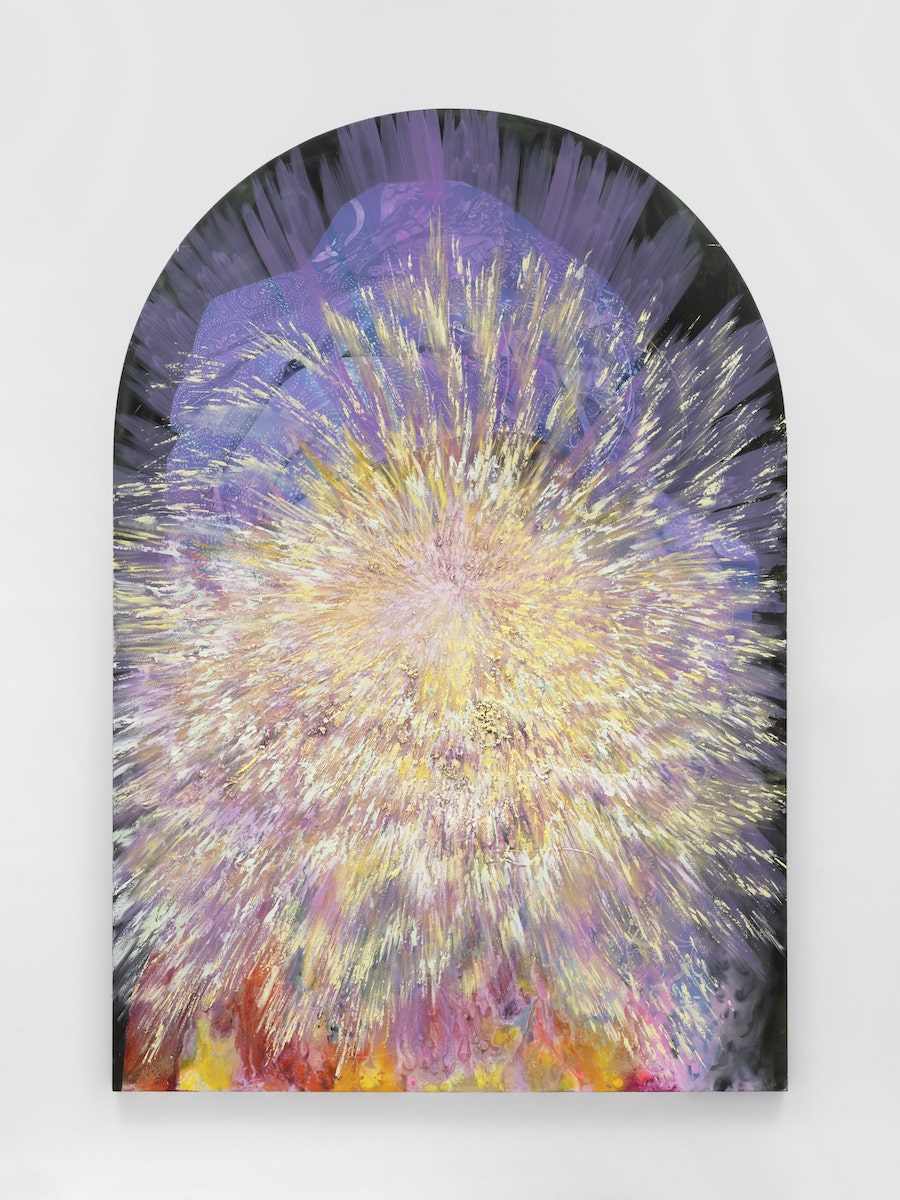
Firelei Báez, “Madeline (Rupture rapture maroonage),” 2022, Oil and acrylic on canvas panel, 113 1/2 x 78 inches; photo by Jackie Furtado, courtesy of the artist and James Cohan, New York.
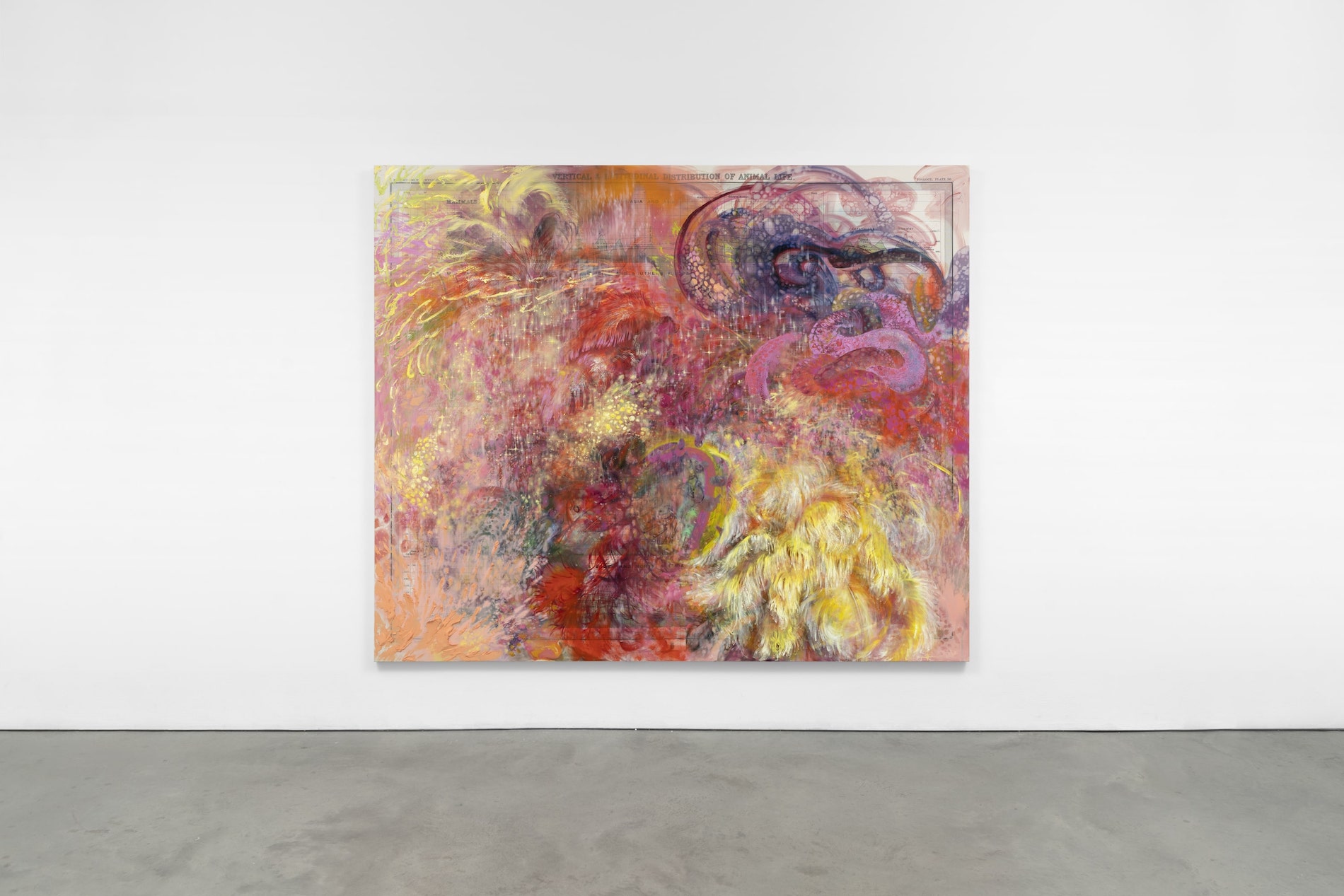
Firelei Báez, “Untitled (Plate 36. Vertical and Latitudinal Distribution of Animal Life),” 2022, oil and acrylic on archival printed canvas, 89 1/4 x 106 3/4 inches; photo by Jackie Furtado, courtesy of the artist and James Cohan, New York.



